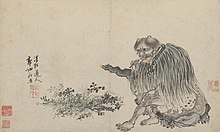
Back ሸንኖንግ Amharic Shennong Catalan Šen-nung Czech Shennong German Shennong Esperanto Shennong Spanish شننونگ Persian Shennong French Sṳ̀n-nùng HAK שנונג HE
| Shennong 神農 | |
|---|---|
| Yan Emperor | |
 Shennong as depicted in a 1503 painting by Guo Xu | |
| Successor | Linkui |
| Born | Jiang Shinian (姜石年) |
| Issue | Linkui |
| Father | Shaodian |
| Mother | Nüdeng |
| Shennong | |||||||||||||||||||||||||||
|---|---|---|---|---|---|---|---|---|---|---|---|---|---|---|---|---|---|---|---|---|---|---|---|---|---|---|---|
| Chinese name | |||||||||||||||||||||||||||
| Traditional Chinese | 神農 | ||||||||||||||||||||||||||
| Simplified Chinese | 神农 | ||||||||||||||||||||||||||
| Literal meaning | "Divine Farmer/Husbandman" | ||||||||||||||||||||||||||
| |||||||||||||||||||||||||||
| Vietnamese name | |||||||||||||||||||||||||||
| Vietnamese alphabet | Thần Nông | ||||||||||||||||||||||||||
| Chữ Hán | 神農 | ||||||||||||||||||||||||||
| Korean name | |||||||||||||||||||||||||||
| Hangul | 신농 | ||||||||||||||||||||||||||
| Hanja | 神農 | ||||||||||||||||||||||||||
| |||||||||||||||||||||||||||
| Japanese name | |||||||||||||||||||||||||||
| Kanji | 神農 | ||||||||||||||||||||||||||
| |||||||||||||||||||||||||||

Shennong (神農), variously translated as "Divine Farmer"[1] or "Divine Husbandman", born Jiang Shinian (姜石年), was a mythological Chinese ruler known as the first Yan Emperor who has become a deity in Chinese and Vietnamese folk religion. He is venerated as a culture hero in China and Vietnam. In Vietnamese, he is referred to as Thần Nông.
Shennong has at times been counted amongst the Three Sovereigns (also known as "Three Kings" or "Three Patrons"), a group of ancient deities or deified kings of prehistoric China. Shennong has been thought to have taught the ancient Chinese not only their practices of agriculture,[1] but also the use of herbal medicine.[2] Shennong was credited with various inventions: these include the hoe,[1] plow[1] (both leisi (耒耜) style and the plowshare), axe, digging wells, agricultural irrigation, preserving stored seeds by using boiled horse urine, trade,[1] commerce,[1] money, the weekly farmers market, the Chinese calendar (especially the division into the 24 jieqi or solar terms), and to have refined the therapeutic understanding of taking pulse measurements, acupuncture, and moxibustion, and to have instituted the harvest thanksgiving ceremony (zhaji(蜡祭) sacrificial rite, later known as the laji(腊祭) rite).[3]
"Shennong" can also be taken to refer to his people, the Shennong-shi (Chinese: 神農氏; pinyin: Shénnóngshì; lit. 'Shennong Clan').
- ^ a b c d e f Ivanhoe, Philip J.; Van Norden, Bryan W. (2005). Readings in Classical Chinese Philosophy (2nd ed.). Indianapolis: Hackett Publishing Company. p. 381. ISBN 0-87220-781-1. OCLC 60826646.
- ^ Christie 1975, p. 87.
- ^ Yang, An & Turner 2005, pp. 190–199.
© MMXXIII Rich X Search. We shall prevail. All rights reserved. Rich X Search